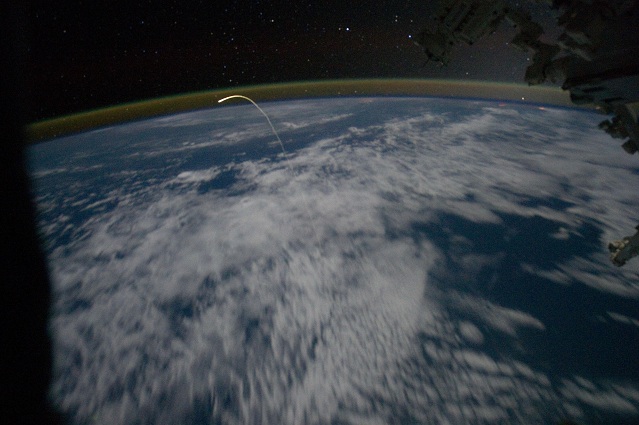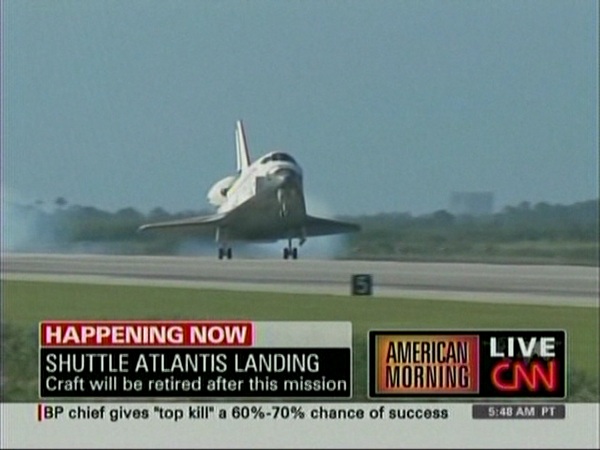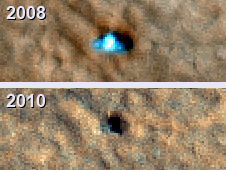Now this is one stunning picture, taken from the ISS of the plasma trail of Atlantis during the spacecraft’s fiery descent into the atmosphere:
RadioAstron, aka Spectrum-R, is in orbit. If it successfully opens its 10-meter dish antenna a few days from now, it will join the list of great space-based telescopes. It also signals that Russia is still a strong space-capable nation, doing much more than cheaply ferrying foreign astronauts to the International Space Station, filling the gap left behind by the retirement of the Shuttle program.
Tomorrow will be the 42nd anniversary of Armstrong’s “One small step”. How many years do we need to wait for the next small step taken by a human, be it in the dust of the Moon, the red rocks of Mars, or the cold surface of an asteroid?
Our paper on the analysis of extended Pioneer 10 and 11 Doppler data was just accepted by Physical Review Letters.
In it, we report that a data set roughly twice in size the data set that was analyzed previously continues to support the notion that a small anomalous acceleration is affecting both spacecraft. However, there is no reason to believe that the acceleration is in the direction of the Sun or that it is constant; on the contrary, the data seem to favor (albeit weakly) an Earth-directed, temporally decaying acceleration model.
Heat, emitted anisotropically, remains the prime suspect. The observed decrease in the acceleration appears more rapid than the rate of decay of the radioactive fuel on board. This is explained once we consider that much of the thermal acceleration would be due to electrically produced heat, and the amount of electricity available on board decreases much more rapidly. (The reason is that as the plutonium fuel cools, the thermocouples used to generate electricity become less efficient; the thermocouples also age.)
We also looked at some early data, taken when Pioneer 11 was cruising between Jupiter and Saturn. The possibility that the anomalous acceleration only began after Pioneer 10 and 11 passed the orbit of Saturn was much discussed in the literature. While we cannot exclude such an onset, its presence cannot be confirmed either (the early data is just too short in duration for a definitive conclusion). In any case, the shape of the onset curve very strongly suggests that it is, in fact, a modeling artifact: it is precisely what one would see if the Pioneer spacecraft’s solar pressure model was miscalibrated, which is a very likely possibility.
In the past few years, we also constructed a detailed thermal model of the Pioneer spacecraft, using recovered documentation and telemetry. We are busy preparing another report in which the results of this effort will be discussed.
Back when I was a high school student in Hungary in the late 1970s, someone gave me a poster of the yet-to-be-tested American space vehicle, the Space Shuttle. This picture stayed on my wall, right above my desk, for many years. Every time I looked at it, I couldn’t help but feel amazed: a space plane the size of a passenger aircraft, flying to orbit and back like there was nothing to it. Now that’s the American space program!
That, of course, was before Challenger, Columbia, and before today. Sadly, today the picture that best symbolizes the American space program is not an image of the Shuttle soaring to the sky, but one of an empty launch pad.
Neither I nor anyone else alive today would likely see the end of such a mission, but… the possibility that I might live long enough to see just the launch of humanity’s first interstellar space mission is simply awe-inspiring.
Of course it’s highly unlikely that it will happen. Mediocrity and politics will see to it that it won’t. But then… Apollo happened, didn’t it? Sometimes, miracles do occur.
Fifty years ago today, Yuri Alekseyevich Gagarin flew into outer space, becoming the first human to orbit the Earth.
I often wonder why it is so that fifty years later, space travel still remains an incredibly expensive novelty. After all, 50 years after the Wright brothers’ first flight, transoceanic air travel was a daily reality, and the jet era and mass air travel were just around the corner.
But then, perhaps it is unfair to compare Gagarin’s flight to that of the Wright brothers. Perhaps it’s more like the Montgolfier brothers’ first manned flight in a balloon, in 1783. After all, a space capsule in an inertial orbit has a lot more in common with a balloon blown about by the wind than a modern, highly maneuverable airplane. So perhaps before space travel becomes routine for the masses, it is essential to make a technological leap similar to that between a primitive hot-air balloon and powered, heavier-than-air flight.
As a footnote of sorts, the maiden flight of the Space Shuttle also occurred on this date, 30 years ago. Unfortunately, the Shuttle was far from being that necessary breakthrough. Its winged elegance notwithstanding, it’s still a chemically powered rocket, and chemical propulsion is just not sufficient… space flight will never become routine if you need 3000 tons of propellant to put a 100-ton payload into orbit.
At the Kennedy Space Center, they began to take the space shuttle Discovery apart, and I don’t feel sad.
Why should I? Come on, these venerable machines are older than most airliners still in service. And taking them apart offers a unique opportunity to learn how reusable space vehicles actually fared after a large number of missions. Besides, some of the parts are truly reusable and may, in fact, end up being used in future hardware. Isn’t that a better legacy than simply stuffing a Shuttle in a museum somewhere in its last flight configuration?
Of course, it means that we lose the illusion that the Shuttle we’re looking at is ready to fly, if only one fueled it up. But then, without an external fuel tank, booster engines, and a launchpad, it’s not like they could get very far anyway.
Amidst all the bad news about crushed uprisings, devastated nuclear plants, and thousands killed by a tsunami, here’s a bit of good news: for the first time in history, a spacecraft is in orbit around the planet Mercury.
It’s official: the work we are doing about the Pioneer Anomaly qualifies as popular science according to Popular Science, as they just published a featured article about it.
I admit that it was with a strong sense of apprehension that I began reading the piece. What you say to a journalist and what appears in print are often not very well correlated, as politicians know all too well. My apprehension was not completely unjustified, as the article contains some (minor) technical errors, misquotes us slightly in places, and what is perhaps most troubling, some of the work that it attributes to us was done by others (e.g., thermal engineers at JPL). These flaws notwithstanding (and this article fares better than most that appeared in recent years, I think), it is nice to have one’s efforts recognized.
A sad anniversary: it was 38 years ago today that a human being landed on the Moon for the last time. Who’d have thought back then that nearly half a century (!) later we have yet to venture beyond low Earth orbit again?
Now here’s an interesting concept for a realistic mission that combines a lunar project with deep space goals: why not send humans on a medium duration manned mission to the Lagrange point on the far side of the Moon?
I like it. I wish I could believe that it would actually happen.
Earlier tonight, we saw this in the sky:
I know, it’s not that impressive. But considering that I took the picture with a camera phone, it’s remarkable that the rectangular shape of this thing is almost discernible:
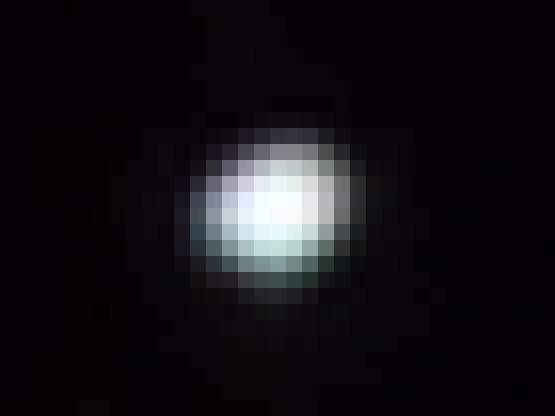 It is, of course, the International Space Station, which flew over Ottawa not long after sunset tonight. It was visible for about a minute or so, then it rapidly faded into darkness halfway across the sky, as it entered the Earth’s shadow.
It is, of course, the International Space Station, which flew over Ottawa not long after sunset tonight. It was visible for about a minute or so, then it rapidly faded into darkness halfway across the sky, as it entered the Earth’s shadow.
It’s been 41 years since Armstrong’s first “one small step” on the surface of the Moon.
Year after year, I express my hope that it won’t take another, well, 41 years before the next step is taken.
Hayabusa, or at least the part of it that was meant to survive atmospheric re-entry, has returned. Hayabusa, also known as MUSES-C, is a Japanese spacecraft, the first ever asteroid sample return mission. Unfortunately it is not yet clear if it has actually managed to collect any samples. Even so, it’s been one impressive mission.
Sitting on the surface of Mars, a space probe that was not designed to survive the Martian polar winter did not survive the Martian polar winter. Not exactly a surprise.
The surprising bit is that another space probe orbiting Mars, designed to operate for two years but still working fine after four, has been able to snap high resolution pictures of Phoenix, which tell us what likely happened: the weight of carbon dioxide snow and ice broke Phoenix’s solar panels.
It is amazing that we have this kind of infrastructure around Mars.
Apollo 13, NASA’s “most successful failure”, was launched forty years ago today. One thing I didn’t know about the timing of the accident is the fact that the tank rupture occurred on the fifth stirring of the oxygen tank, which normally would have taken place 120 hours into the mission, when the lunar module was already on the Moon’s surface. Without the lunar module to serve as a lifeboat, the fate of the spacecraft would have been sealed. However, an unrelated sensor problem caused them to stir the tank more frequently, causing the accident to occur earlier.
Had the crew of Apollo 13 died in space, it has long been assumed that their spacecraft would have served as a frozen tomb for their bodies, orbiting the Sun. But now, some argue that the orbit of Apollo 13 was such that it would have returned to the Earth and burned up in the atmosphere just a few weeks later. I am not sure how you can really tell, with uncontrolled gas leaks, a tumbling spacecraft, and no precision radio-metric navigation data.
It was a rare night-time landing, but Endeavour is safely back home. The sight of an open flame from that venting on top, only visible at night, is positively weird: combined with the sound effects, it’s as if it was an overheated steam locomotive, not a space plane huffing and puffing on that runway.
Four more Shuttle flights to go, one of them by Endeavour. After that, for the first time since the 1960s, the United States will have no manned space flight capability. Hopefully not for long.
Steven Weinberg has an opinion piece on the Wall Street Journal Web site, where he expresses confidence that Obama’s NASA budget is the right one. Instead of wasting money on a manned space program that is self serving (i.e., other than putting men in space, it accomplishes nothing) more money will be available for doing real science, he thinks.
He has a point… but, well, but there is a but. Science is an important goal of the space program, but it’s not the only goal. As a matter of fact, if you ask me as a taxpayer why I think it’s a good idea to spend some tax dollars on the space program, scientific research is just one of the reasons I’d mention, and not even necessarily the first reason. People should travel in space because our future is in space. The steps we’re taking today may be baby steps, but they’re still important steps… even if a future with colonies on Mars, manned exploration of the outer planets and their moons, or perhaps travel beyond the solar system is decades, if not centuries away.
Having said that… the Constellation program, effectively repeating the accomplishments of Apollo with slightly upgraded hardware, may not have been the smart thing to do even if it had been funded right, which it wasn’t. Another footstep on the Moon is not the same as sustainable manned deep space exploration. If I recall, one of the Augustine commission’s suggestions was a deep space program without a specific landing objective; one that focuses on developing capabilities more than achieving spectacular “footstep-and-flag” milestones, “landing” only on asteroids, if at all, focusing instead on long-duration flights in deep space. If this is the space program Obama’s administration is about to establish, who knows? Perhaps he’s putting the space program on the track that it should have been put on decades ago. (Then again, perhaps I’m just an incurable optimist.)
As a footnote of sorts, I find it noteworthy that, more than 50 years after Sputnik, there is still only one nation on Earth with a comprehensive deep space research program: the United States. Much of the Soviet space program died an undeserved and premature death after the collapse of the Soviet Union; as to China, India, Japan, the EU and other nations, their efforts are commendable but that still leaves them in the “also ran” category.
Here’s a nice tennis ball, photographed from both sides:
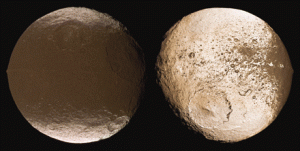 It’s a big one, mind you, almost a thousand miles across. It’s Saturn’s moon Iapetus, famous because one side of it is significantly brighter than the other. The explanation, however, is more mundane than that offered in the book version of Clarke’s 2001: A Space Odyssey; the most recent hypothesis is that the discoloration is due to the thermal migration of ice.
It’s a big one, mind you, almost a thousand miles across. It’s Saturn’s moon Iapetus, famous because one side of it is significantly brighter than the other. The explanation, however, is more mundane than that offered in the book version of Clarke’s 2001: A Space Odyssey; the most recent hypothesis is that the discoloration is due to the thermal migration of ice.
